
Since 2013, I have led more than thirty collage sessions, and each one has testified to the power of art to nudge emotions, memories, and personal wisdom to the surface. Bridging visual and linguistic boundaries, collage creates a world of meaning in which a yoga pose, a set of stairs, and a gold coin symbolize an immigrant’s struggle to regain lost ground. As an artist and ESL educator, I appreciate collage’s unique ability to sound the depths and reveal insights that elude verbal access, thus providing a perceptive gift that builds second-language fluency and morale. Having witnessed the alchemic energy that transforms ordinary paper and glue into artistic creations, I would like to share my collage-teaching experience with a wider audience. To showcase the learning potential of this versatile modality, I will focus on the process of workshop preparation, execution, and closing harvest.
Whether conducting a session with my own students or visiting the ESL classes of colleagues, I am delighted to promote collage as an educational tool. To harmonize proposed collage lessons with the curriculum, they are usually given a theme connected to relevant textbook chapters, and some typical ones have included Relaxation, Health, Nature Conservation, Families, and Personality Traits. The artwork that results from these themed sessions provides meaningful material for discussion and written reflection, which instructors often incorporate into assigned presentations or paragraphs.
With a theme and a firm date established, workshop preparations start with a dive into several thick folders from my picture collection (an entity that has taken on voluminous dimensions of its own). As I search for images that can be tailored to the theme, I celebrate the latent promise of diverse colors, textures, shapes, and lines found in magazines, leaflets, wrapping paper, hand-made paper, tissue paper, fancy bags, and commercial packaging. While sorting through the folders, I often contemplate the artistic destiny of items such as a page from a Rumi calendar or a stamp from an old postcard. After the image folders have been customized for a particular class, I gather the requisite backings, scissors, glue, and embellishments, sometimes making flying visits to the dollar store if necessary.
When the day of the session arrives, I shoulder two large bags full of materials and make it my mission to fire up enthusiasm for art, an attitude that lays the foundation for a lively and productive session. Upon arrival at the designated classroom, I ask for a show of hands to gauge how many participants have tried collage before. If the term is unfamiliar, I show them a sample collage and call attention to the French origins of the word (coller, to glue) while flourishing a glue stick in the air. Then I explain that collage is a process in which different pieces of paper are arranged and glued to a backing to create a new piece of art.
Before the actual collage-making begins, I assure the class that drawing skills are not a prerequisite. Hoping to alleviate possible anxiety over creative deficiencies, I strive to foster a non-judgmental learning environment, for I want participants to feel free to take a playful approach to the activity, setting aside worries about making mistakes. Thankful for the respite from critical evaluation, many students find that cutting, tearing, and pasting can relieve the stress of testing, grades, and error-correction, all of which permeate second-language study in college. Moreover, a relaxed approach gives participants the chance to defy negative beliefs such as “I am not creative” and let their imagination surprise them.
To avoid slowing the session’s momentum with overly-detailed instructions about technique, I prefer to pass around several examples of previous students’ artwork and let these exemplars provide inspiration. After the samples have made their rounds, I ask each person what colour of backing they would like and supply the tables with scissors and glue. Then it is time to release multitudes of papers from their orderly folders into gloriously messy piles. As colourful items spill out with abandon, eager hands pounce on individual images that clamour to be chosen. When I see how swiftly the learners become engrossed in gathering their images and committing to a mental picture of what they want to create, it makes me happy.

Once the session is in full flow and the students completely immersed, it is fun to intensify the joyfully-strewn chaos of materials by adding alphabet stickers, stencils, markers, fake jewels, ribbons, and tissue paper to the mix. With student-selected music playing in the background, the room hums with kinetic engagement, which is in dramatic contrast to the traditional pedagogical tableau of quiet students in rows of desks, immobilized by lectures. Instead, workshop participants are free to stand up and browse materials on other tables or study the composition of classmates’ collages. As the dynamic work continues apace, someone might call out a request for a fish, a field of snow, or a feather, and these calls activate a general scramble to oblige the seeker. Invariably, cries for vowels become increasingly urgent as the sheets of alphabet stickers become more and more depleted. When requested letters or visual items are unearthed, it is rewarding for the helpers because they have provided exactly what fellow artists need to realize their visions.

Near the end of the workshop, busy heads bend low over the tables in a final burst of concentration, determined to add finishing details like a border of faux pearls or a tissue-paper flower with a questing bee. One by one, collages are declared finished, admired by onlookers, and then placed in a spontaneous classroom gallery that is curated with the aid of masking tape or magnets. To gaze at the rapidly-expanding galleries that emerge is to be awed by the creativity, energy, and humour on display, which is visible in spirited details such as a giraffe with a bedazzled purple bow-tie or two loops of string affixed by blue gems that seal the eyelids of an anguished god.
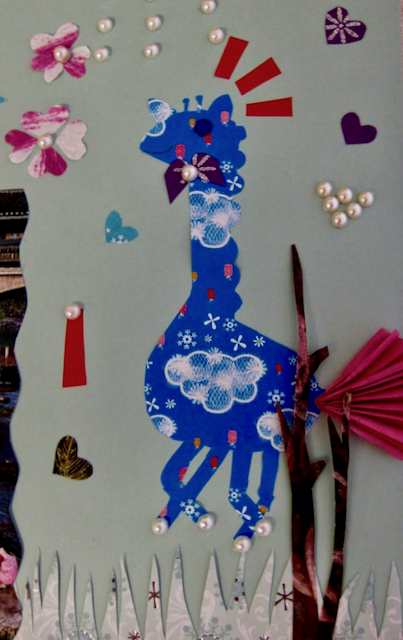
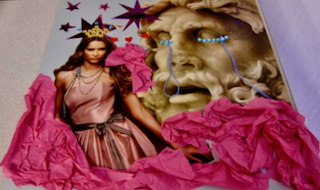
As soon as the galleries are complete, cellphone cameras click like mad, capturing each learner’s individual work and that of their classmates. Sometimes students will make videos of the displays, walking slowly to savour each artistic offering. Whether they record the collective works or simply examine them, it is heartwarming to see groups of rapt students standing in front of the exhibits and exclaiming over art that had not existed two hours previously. Gazing at evidence of simple materials magicked into art by virtue of imaginative effort rarely fails to impact viewers; collage reminds us that creativity is our human birthright.
Thanks to the pop-up exhibits, fresh artwork now brightens classroom walls and serves as a rich resource for written and verbal responses. For example, the following transcription of a collage presentation in a beginner’s ESL class contains visionary wisdom: “Sometimes we hear a noise and we think . . . it is something dangerous . . . but usually it’s something like this cute dog who want to play . . . Fear pulls you back. If we release our fear, we can reach to the stars” (Sergi, 2013). Sergi’s classmates and I were inspired by the comforting message of his piece, which stays with me to this day.
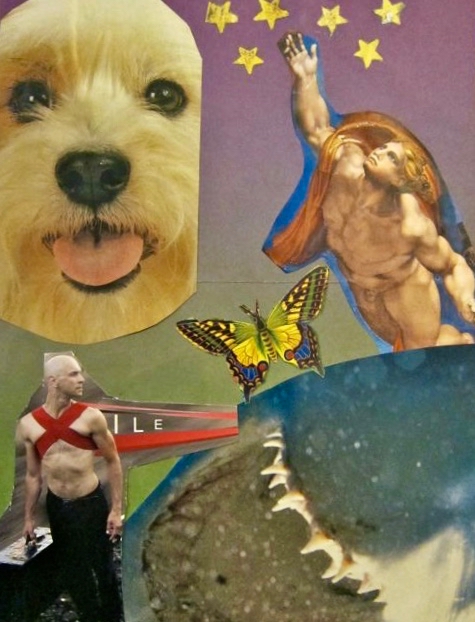
I am very grateful for the courageous willingness of over 350 students like Sergi to try an unconventional classroom activity that encourages camaraderie, poetic thinking, and artistic confidence. Until the next collage workshop, may your garden be protected by an Ewok and your baby panda lulled to sleep by a lute.
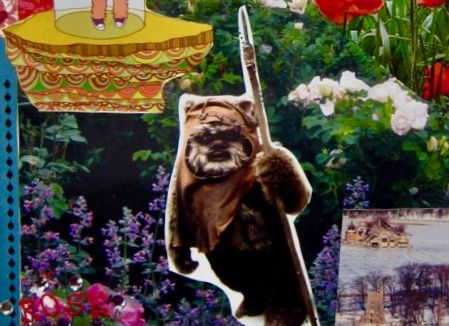
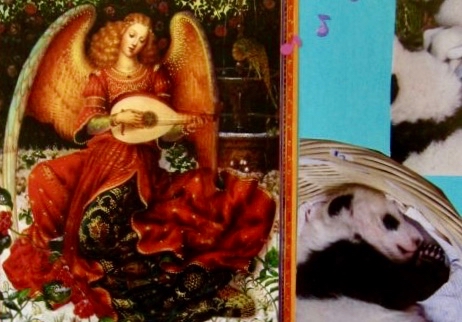
Note: A version of this essay was first published in the Marshall Alumni Newsletter, Fall 2018
One reply on “Collage Workshops Spark Language Expression”
Your collage classes are inspiring! Thank you!!